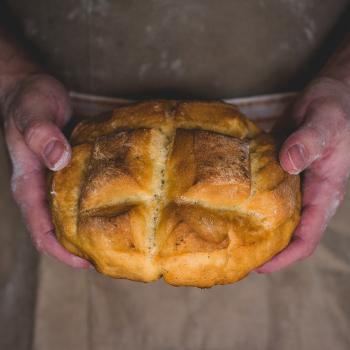I'm a sucker for an evocative religious Christmas card. This year the family card depicts baby Jesus leaning into Mary's breast asleep. The true-to-life posture of the sleeping infant turned toward Mary makes me think the Babe is being comforted by the presence of his mother's heartbeat under his ear.
(And I wonder, too, how many times it might have been the opposite, when Mary held her own ear close enough to the Child to hear his Sacred Heart beat?)
Mary was the first human person to know Jesus in an intimate way, primarily in her maternity and mothering of him.
Surely while pregnant she experienced "the quickening" . . . the sensation of movement of the nascent child within her womb. It is the awesome presence of another. Only in Mary's case, she encountered the Holy Other: The presence of God who took on her flesh.
One day, she discovered the subtle movement of the baby within. And soon it was not so subtle, but active and vigorous! Another heart was beating. Another's blood circulating, another soul's verve kicked and stretched, or lay still, in utero, contented by mother's heartbeat.
Talk to any mother and you will discover that these sensations signal the start of a mother's strong identification with her child. And this relationship grows as a mother submits and commits her body and lifeblood evermore profoundly to the protection and wellbeing of that child.
Mothers come to know their biological children in a way that defies proper explanation. This heartbeat and these first stirrings are an advent of that first encounter face to face. And mothers expectantly await the meeting of this tiny one they know somewhat dimly, and yet intimately.
Presence. Heartbeat. Blood. Life. Relationship.
These are not just the proximities of maternity; they are the stuff of the once-invisible and inexpressible God entering our humanity and cleaving to us in ways unimaginable yet tangible. They hail Immanuel, "God-with-us" (Is. 7:14; Mt. 1: 23).
And Mary gave birth to her first-born son and wrapped him in swaddling cloths, and laid him in a manger . . . (Lk. 2:7).
What started with Mary's maternity has ramifications for all of us. Mary's precious womb contained the Body of Christ.
Two millennia later, Christians still recognize the Eucharist as becoming the true Body and Blood of Jesus (Jn. 6:53-56). Eucharist is the sublime privilege of receiving Jesus inside our very selves bodily.
Do we dare contemplate this? The heartbeat of the Holy One, the life of Jesus himself—his Body, his Blood—inside our very being?
Yes. And we have Mary to thank for shedding light on this.
Just as Mary said "yes" in receiving him (Lk. 1:38), so must we. Jesus is the truth, and the life, and He made for us, a way (Jn. 14:6). Christ, God-with-us, came to love us and to actually live inside us in a way that defies proper explanation in that it is transcendent.
Recall the Passover: the meal reminded the Jews of God's intimate love, protection, and nourishment for them en route to their freedom from slavery to the Promised Land. The Eucharist, given to the apostles at the Last Supper, is the Savior's gift to humanity to remind us of his intimate love, protection, and nourishment for us en route to freedom from sin and death to the promise of Heaven.
When receiving the Eucharist, we experience the closeness of Another—God real and present with us and within us: His heart . . . his holy blood . . . his very life within us. It is the closest of relationships. Eucharist is an invitation to draw ever-nearer, this Christmas, to the One who loves us beyond our imaginations, tangibly. It is the Advent of our meeting him, One Fine Day . . . "face to face" (1 Cor. 13:12).
But until we do, in the waning days of this Advent, perhaps we might send a few Christmas cards, or similar greetings, reminding one another of the great truth of this presence: Christ's heart is turned toward us. Yet we must still discover its beating; we must lean into him, like the beloved disciple leaned on the Savior's chest at the Last Supper (Jn. 13:23) or, as a Child of God might sleep content against his mother breast . . . as we wait in joyful hope for the coming of the Kingdom.
"Advent" is a Latin word that can be translated as "presence" or "coming." In the ancient world, it was a technical term, denoting the arrival of a person in office such as a king or emperor. It could also indicate the coming of a deity in which case the god's advent was his emergence from concealment and making his presence known in power or else having it solemnly celebrated in an act of worship. Christians took over this word in order to express their particular relationship with Jesus Christ . . .
What Christians mean by this word "Advent," then, is: God is there. He is not withdrawn from the world. He has not left us alone . . .
The beauty of Advent can be a personal Advent—a visit by God who wants to enter my life and turn toward me. ~ Seeking God's Face, Joseph Ratzinger [now Benedict XVI] (Franciscan Herald Press, 1982, pp. 74-75)
12/16/2010 5:00:00 AM





